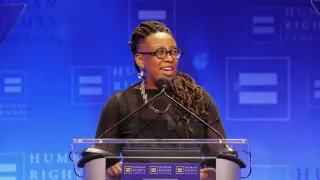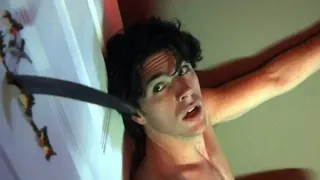September 26, 2024
Qultur: How Did a Jewish Queer Man From Brooklyn Change the Face of American Music?
READ TIME: 8 MIN.
This is the first in a series of columns called "Qultur" that will look at how queer artists helped define American culture.
This week the Boston Symphony Orchestra presents an all-American music program that opens and closes with two 21st century works: Sarah Kirkland Snider's "Forward into Light" and Carlos Simon's "Wake Up: A Concerto for Orchestra." Between them are two works from 20th century American composers: Aaron Copland's "Clarinet Concerto" and Samuel Barber's "Adagio for Strings." (For more on the concert, conducted by Music Director Andris Nelsons with clarinet soloist William R. Hudgins for the Copland Concerto, click here.)
The latter two works are by queer American composers, which brings to mind a curious development in American classical music in mid-20th century America: how the "American Sound" was developed by this so-called "gay mafia," with Copland as its don.
It is a theory developed by modern queer musicologists and biographers who reexamined the classical music trends in American composition from the last century. During that time the idea that American music was being defined by this marginalized group wasn't part of the public discourse; rather it was, at best, a secret in the musical world, that was often described in homophobic terms. The concept can can be traced to musicologist Nadine Hubbs, a professor of music and women's studies at the University of Michigan, whose 2004 book, "The Queer Composition of America's Sound: Gay Modernists, American Music and National Identity," gave a new perspective on the numerous number of queer composers writing in that period and their contribution to the sound of American music.
It was the first book to bring together the contributions of the group of queer composers, a circle that included Copland, Virgil Thomson, Leonard Bernstein, Marc Blitzstein, Paul Bowles, and David Diamond, that favored tonal music in the creation of an identifiable sound that even today signifies "America" in commercials, movies, radio and television, and the concert hall. To these names, add Barber, Gian Carlo Menotti, and Ned Rorem, who Hubbs would later cite as contributors.
Hubbs' book created a minor uproar when it was published. In a New York Times commentary, critic Anthony Tommasini wrote it tries to prove that what has come to be considered "the distinctive American sound in mid-20th-century American music -- that Coplandesque tableau of widely spaced harmonies and melancholic tunes run through with elements of elegiac folk music and spiked with jerky American dance rhythms -- was essentially invented by a group of Manhattan-based gay composers."
In the 1920s, Copland studied under the French master Nadia Boulanger, who encouraged him to find his own voice. At first, he didn't, writing in the atonal style derived from Schoenberg's 12-tone theories that were prevalent in composition in the 1920s and 1930s. But he abandoned it to develop a simpler, more emotional style by incorporating popular musical elements, such as 19th-century folk songs and elements of 20th-century jazz, into his symphonic works. This was no innovation and Copland was already well-connected in the musical world. What he saw was the possibility of a populist composer. "I see no reason," he wrote, "why composers any longer should write their music solely with the concert audience in mind. New listeners, such as the radio provides, may not be cultivated listeners, but at least they have few of the prejudices of the typical concert-goer."
This change began in 1936 with "El Salon Mexico," a tone poem he wrote while visiting Mexico City with his companion Victor Craft, to whom he dedicated the work. It was based on visits the couple had to the piece's titular Mexican dance hall, which led Copland to incorporate Mexican folk songs into his symphonic score. Works like the ballet scores to "Rodeo," "Billy the Kid," and, most notably, "Appalachian Spring," established him as a celebrity. In the 1940s, his brief "Fanfare for the Common Man" was the most popular piece of American music. And not only was his music heard in concert halls throughout the world, it was heard in movie theaters as well in eight film scores, which included "Of Mice and Men," "Our Town," "The Red Pony," and "The Heiress," for which he won an Oscar. He was condescended to by the musical intellectuals, though found a hugely influential ally with Serge Koussevitzky, the great champion of new works during his lengthy tenure as the conductor of the Boston Symphony. Koussevitzky commissioned Copland's Third Symphony and conducted its premiere with the BSO in 1946. "There is no doubt about it -- this is the greatest American symphony," he said. "It goes from the heart to the heart."
That emotional appeal may be the key to what made Copland so accessible to a concert-going public wary of the intellectual demands of more serious, serial music. And the move was an anathema to the prevailing idea that tonal music was dead.
"How did it happen that this cherished national music, what I am calling America's sound, came to be composed by a gay man in the most homophobic period in U.S. history?" Hubbs asks in another remarkable essay, "Homophobia in Twentieth-Century Music: The Crucible of America's Sound". "And what does it mean that the America of prairie cowboys and pioneer newlyweds was rendered musically by this leftist, Jewish homosexual from Brooklyn?"
But, she also points out, Copland did not do this alone. "Rather, there was a whole posse of gay composers–and a famous lesbian author (Gertrude Stein), to boot. This is not entirely a new idea. For decades, rumors churned in the classical music world about the 'gay mafia' that ruled American composition."
Hubbs continues: "These rumors were deeply homophobic, but I want to pay close attention to them nevertheless. They speak to us of what was feared and loathed in this context and period, roughly the 1930s through the 1970s. There was fear and loathing not just for the notion that influential gay composers were on the scene, but for the idea that they constituted some sort of group. This did not jibe with the prevailing heterosexual and patriarchal ethos. A real man is a rugged individualist. A real composer is a solitary genius. And conventional wisdom held that behind every great man stood a loving and devoted woman."
The person who stood by Copland was often the handsome, younger man he was involved with, and they included artists Alvin Ross, pianist Paul Moor, dancer Erik Johns (librettist for Copland's opera "The Tender Land") and composer John Brodbin Kennedy. (For an illuminating essay on Copland's sexual life, click here.)
The irony that the sound of modern American symphonic music was invented by a cadre of urban queers would surprise many. This also put the group at odds with the prevailing straight composers of the time, such as the strongly individualistic Charles Ives, who considered his younger peers, in his word, "sissified." He wanted the audience to stop whining and take its dissonance like a man. Comments by other straight composers of the time only show how deeply rooted homophobia was in the musical world. "Use your arse like a prick garage–or your mouth as a night lodging . . . and N(ew) Y(ork) is yours," said French emigre Edgard Varèse of Copland's success in a letter to fellow composer Carl Ruggles. And when Copland mistakenly made a pass at straight composer Roy Harris, he was not only rebuffed; his contributions to American music were questioned when Harris claimed that Copland was not the "authentic musical voice in America." Instead it was Harris who called himself "the Walt Whitman of the concert halls."
Varèse's comment points to the element of envy there was in classical musical circles at the success of Copland and his followers. While the straight composers took what critic Susan McClary called the "moral high ground of modernism" – that is, writing works in the style of Arnold Schoenberg and his followers that fell warily upon audiences' ears – Copland and others were having success in the concert hall with far more accessible music. Composer David Diamond recalled: "The resentment was quite strong, especially among people who wrote very difficult music... They simply felt that homosexual and bisexual composers were the most successful, and they were plainly jealous."
But were these queer composers able to convey their feelings about their sexuality into their music? As it turns out, Copland did in the first movement of his Clarinet Concerto, to be played by William R. Hudgins under the direction of BSO musical director Andris Nelsons, in this weekend's BSO concerts. According to his biographer Howard Pollack, his signature "bittersweet lyricism," as expressed in the first movement, was influenced by his feelings of loneliness and social alienation over his homosexuality.
Copland never hid his homosexuality from friends and colleagues, and was often seen in public with the younger men he was dating. But going public was not in the cards. "In the beginning of the gay rights movement in the '60s and '70s, people like Leonard Bernstein encouraged him to come out, but his response was, 'I'll leave that to you, Lenny,'" writes musicologist Luke Jensen in the Washington Post. "He was not interested in being an activist on the issue. I don't think he made much of an issue about it himself."
He was very comfortable with his sexuality. Out composer David Del Tredici recalled, "In private he was very open about being a gay man. He'd joke about it. It was perfectly natural." One such joke was that once after a good-looking student walked by, Copland, who had written three symphonies, remarked to a friend, "There goes my Fourth Symphony."
The Boston Symphony Orchestra presents a concert with works by Snider, Copland, Barber, and Simon on Thursday, September 26 at 7:30 p.m., Friday, September 27 at 1 p.m., and Saturday, September 28 at 8 p.m. at Symphony Hall, 301 Massachusetts Avenue, Boston, MA. For more on the concert, click here.






